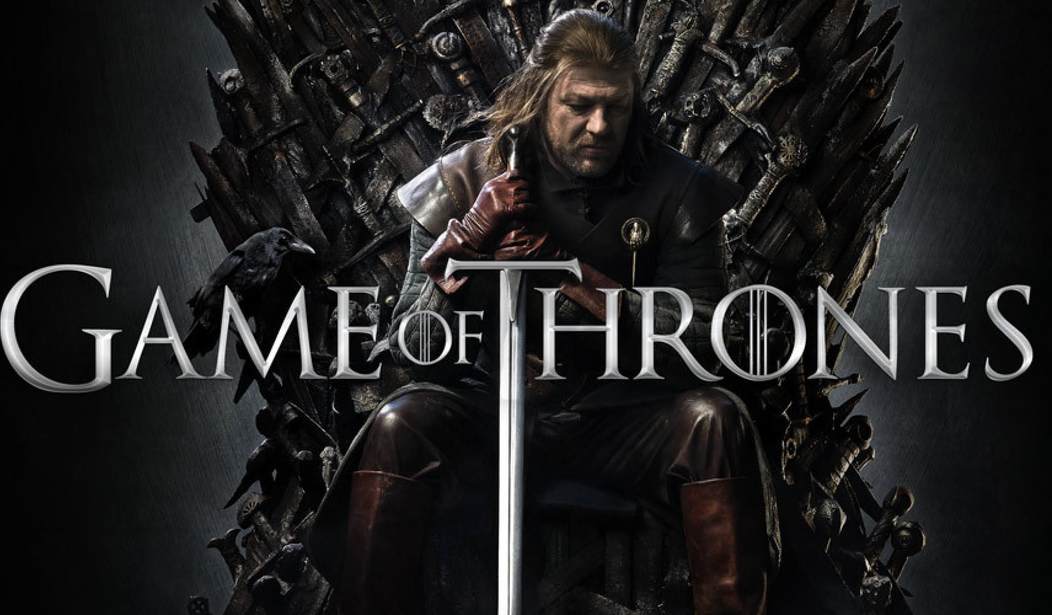From the first season onward, Game of Thrones has featured heavy skepticism. In a world with dragons, ice zombies, demon spirit babies, and humans controlling the minds of animals, people don’t believe in magic. Even with strong fantasy elements, the show and the books on which it was based inverted the literary tropes, killing heroes and elevating villains.
After the big reveal in the most recent episode, however, the cat is entirely out of the bag. Supernaturalism is the rule of the day, and the central event is a major coup for heroism. Does this mean Game of Thrones is going the way of The Lord of the Rings or Harry Potter? I wouldn’t be so certain. Nevertheless, here are three ways the show’s latest episode echoed J.R.R. Tolkien and J.K. Rowling
1. Jon Snow and Gandalf the White.
Jon Snow is back from the dead! Now the show that brought you the death of the heroic Ned Stark, his noble son Robb, and even his (?) bastard son Jon Snow is flipping its own narrative on its head. The show already had dragons and White Walkers — now it has resurrection too.
This is quite striking, given that George R.R. Martin explicitly rejects “the sort of fantasy where all the people get together to fight the dark lord.” In a New Republic interview in 2013, the author behind the books said he wanted to create a world like ours, where heroes and villains are mixed and characters constantly struggle within themselves.
Martin’s works feature a great deal of pessimism, and there has been speculation (from Preston Jacobs, a YouTube star steeped in Martin’s writings) that Game of Thrones actually takes place in a post-apocalyptic universe, rather than a pure fantasy world. This would help explain the purposeful moral ambiguity throughout the work.
This is why it is such a big deal for pessimist author George R.R. Martin to raise a hero from the dead. Fans of the books and the show have been expecting it for some time, but that fact does not make it less remarkable. While Jon has only come back in the show, and the books are different, this is an event both will likely share. Jon’s resurrection suggests that Game of Thrones might bring back something we haven’t seen since the first season, hope for a better world.
Now, Jon Snow is likely to have changed due to his experience with death. Thoros of Myr, the Red Priest who resurrected the lord Beric Dondarrion from the dead back in Season 3, explained that each time he brings Beric back from death, the lord is “a little bit less.” Magic always comes at a price in Martin’s world, and Jon Snow is likely to be no different.
Nevertheless, Jon Snow is likely to rise a hero, and if rumors of his parentage are correct, he may just be the rightful heir to the Seven Kingdoms of Westeros. This storyline might end up mimicking the story of the Lord of the Rings character Gandalf the Grey, who died in The Fellowship of the Ring only to be resurrected in The Two Towers.
The resurrected Gandalf was more powerful than before his death, but even he had to fade and die at the end of The Return of the King. Is Jon Snow back with a vengeance, but only for a little while? George R.R. Martin teased a “bittersweet” ending for the series — could this be it?
Next Page: Tyrion Lannister and dreams coming true.
2. Tyrion Lannister’s dreams come true.
One of the most powerful scenes in the episode featured the dwarf Tyrion Lannister releasing the huge and terrifying dragons. As he approaches the mighty beasts, the little lord tells them a story. He knows that they are intelligent, and he guesses that they will connect him with their “mother,” Danaerys Targaryen.
His words indeed soothe them, but what he says, more than almost anything else in the entire episode, fits the fantasy genre to a T. Tyrion tells the dragons that they are his dream come true. “When I was a child, my uncle asked what gift I wanted for my name-day. I begged him for one of you — it wouldn’t even have to be a big dragon, I told him, it could be little, like me.”
“My father told me the last dragon had died a century ago,” the dwarf continued. “I cried myself to sleep that night, but here you are.” As Tyrion frees one dragon from his chains, the other turns to him, imploringly. The moment is perfect fantasy, much like Harry Potter realizing he is a wizard and being invited to the wizard school, or Samwise Gamgee picking up the sword Sting to come to the aid of his friend Frodo. The little, seemingly insignificant man discovers that his dreams have come true. What could be more satisfying than that?
Next Page: Brandon Stark and the Pensieve/Palantir
2. Bran Stark and the Pensieve/Palantir.
The latest Game of Thrones episode brought back a character we hadn’t seen since Season 4, Bran Stark. Bran is training with the Three-Eyed Raven, also known as Lord Bloodraven, Brynden Rivers, and he seemingly has the ability to travel back in time. This is due to the Weirwood trees worshipped as the “old gods,” and because Bran has the special ability of tapping into the trees’ memories.
Bloodraven is training Bran to use this network of trees, but the allure of a happy past makes Bran wish he could stay forever. We do not know why Bloodraven wishes Bran to hone his abilities, and whether or not he will be able to use them against the White Walkers. There is an outside chance he may be wishing to manipulate Bran.
Similar memory and seeing devices exist in Harry Potter and The Lord of the Rings. In Harry Potter, the pensieve allows someone to store their memories, and share them with someone else, or to relive them in a semi-dream state. Harry sees his father, and wants to spend more time learning about his dad. In The Lord of the Rings, the palantir is a device which allows someone to communicate by seeing what is around other palantirs. Pippin is entranced by the object, and touches it, accidentally revealing himself to the ultimate villain. In this way, the power manipulates Pippin into revealing himself.
The scene in Game of Thrones Season 6 Episode 2 explicitly evoked scenes in Harry Potter where the headmaster Albus Dumbledore trains Harry by showing him Voldemort’s old memories in the pensieve. As Bran sees more visions in the Weirwood network going forward, he might learn about Jon Snow’s parentage and he may develop into a very powerful factor in the war to come.
Next Page: Villains and Good and Evil
3. Villainy exists in all worlds.
“We don’t tend to have wars or political controversies where one side is really ugly and wears dark clothing, where the other side wears white and has glowing magical swords,” Martin told the New Republic. “It is never clear who is a bad guy and who is a good guy, who deserves to be supported.”
This view leads to some truly wonderful reveals in Game of Thrones, such as Jamie Lannister explaining why he killed the “Mad King” Aerys II — to save the population of King’s Landing. He is known as an oathbreaker, but he only broke one oath (protecting the king) to fulfill another (defending the weak). This does not excuse him throwing Bran from a tower, but it does make him a rather compelling character.
Nevertheless, even Game of Thrones has been unable to escape the hero-villain dynamic. In Seasons 2-4, the boy king Joffrey Baratheon personified evil, and in Seasons 3-6, Ramsay Snow Bolton has largely taken his place. These characters do enjoy more development than Sauron in The Lord of the Rings, although perhaps less than Voldemort in Harry Potter.
Nevertheless, as both show and books illustrate, they are absolutely wicked characters who deserve their comeuppance. Indeed, you could make a case that the dynamic of these villains show that morality is inescapable, even in a world seemingly designed to thwart the victory of good at every turn.
In the latest episode, Roose Bolton, Lord of the Dreadfort and Warden of the North, learns that his wife has given birth to a legitimate baby boy. This is a threat to his newly legitimized bastard son Ramsay, and Ramsay acts swiftly — stabbing his own father and killing his stepmother and half brother in a gruesome and terrifying way.
In one fell swoop, Game of Thrones reiterated Ramsay’s evil while also giving Roose Bolton the ignominious death he deserved. Roose had, after all, betrayed Robb Stark, and delivered the chilling final blow. Now, he died in the same way, stabbed by someone close to him. The betrayer has been betrayed.
Notably, this episode also killed off Balon Greyjoy, the last of the five kings in the “War of the Five Kings.” Euron Greyjoy, the younger brother who kills Balon, is likely to emerge as another villain, driven by power to do horrible things.













Join the conversation as a VIP Member